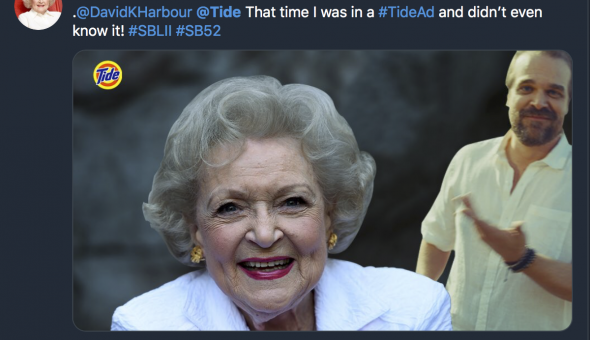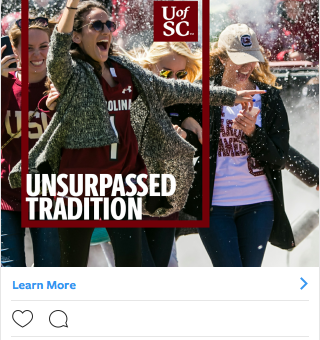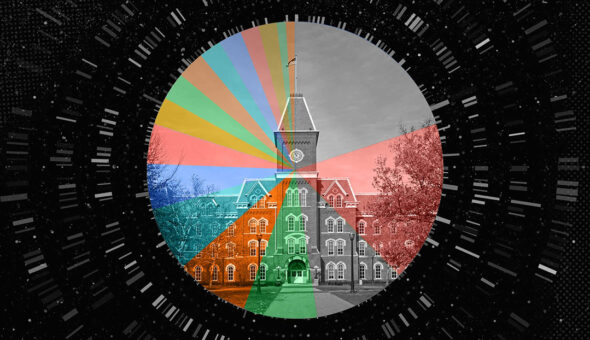Sunday night wasn’t just the biggest football game of the year (congrats, former Gamecock, Rashad Fenton – oh, and Andy Reid and all of Kansas City), but it was – and always is – the biggest event of the year in American marketing and advertising. At no other time does such a large audience gladly collide with marketers backed by enormous budgets. Marketers of all stripes can learn from the Super Bowl spots, but for higher-ed marketers and enrollment managers, in particular, these omnibus, fully-integrated campaigns provide blueprints to develop new ways to plan marketing and recruitment campaigns.
Creating Super Moments: What the Super Bowl Can Teach Us About Higher Ed Marketing Campaigns
The Super Bowl gave us more than just strange and memorable ads, it reminded higher ed marketers of how essential it is to create strategically integrated digital ad campaigns.

It’s not a stretch at all to see how the Super Bowl can provide a game plan (pun intended) for higher-ed marketing campaigns.
1. First, the Super Bowl offers insightful ways for marketers at schools of any size to think about how media can be sequenced and varied to strengthen message encoding, increase recall and decrease burnout.
2. Second, and this is especially relevant to D-1 schools like my own University of South Carolina, it provides an interesting parallel for major media moments like college football rivalries. Called the “Kicker Effect,” television and digital advertising have been shown to produce the highest return on investment, in terms of media combinations. The combination allows brands to not only reach a larger part of their target audience, but also drive key efficiencies in audience targeting.
3. Finally, practitioners can extend these learnings and apply them to major moments in the customer journey. While sports signify cultural moments, there are patterns within the buying process that are shared among segments. Just like the Super Bowl, a school’s integrated marketing campaign may pique a prospect’s interest with a televised ad – or a banner ad, if that’s more your budget – then beckon them to a readymade hashtag, and then draw them to an interactive landing page, and finally, guide them all the way down the funnel to enrolled student.
The more we create synergies across channels and across entry points, the more impactful and efficient our efforts can become. And especially given higher-ed marketing’s continuing need to develop a robust series of communications activities to drive razor-thin yield efficiencies, finding new ways to integrate our efforts may produce better results than adding more communications to our lists.
As the winners and losers from Sunday night’s game get sorted out, here’s are some key lessons in cross-channel strategy that previous ad campaigns from other recent Super Bowls successfully demonstrated.
Get Pumped Up: How Tide ‘Primed’ 103 Million Viewers
During Super Bowl 52, audiences were treated to Stranger Things fan favorite David Harbour gazing longingly into the camera and proclaiming, “Just your typical Super Bowl ad, right?” Harbour proceeded to mock just about every major category convention, leaving the audience wondering what ad may ultimately turn out to be another Tide ad.
Tide’s campaign is a textbook example of priming, as described by Erik du Plessis in his 2008 book, “The Advertising Mind.” In it, he describes the importance of emotion in advertising: “Emotion in advertising is important in getting our attention. And what we pay attention to gets remembered. And what we have paid attention to and remember in the past, makes us more likely to pay attention to in the future.”
Not only was the Tide campaign a creative home run, the first spot evoked just enough emotion that we continued to extend the possibility that anything could be a Tide ad, leaving the audience ‘primed’ to receive additional messaging. As the game continued, the Tide concept would make its way into additional commercial spots, in-game promos and made-to-look-like P&G brand ads (Old Spice and Mr. Clean), strengthening the heuristic connection between Tide and “stain-fighting.”


This media effect, known as image transfer, extended Tide’s priming effects and helped to encode associations of cleanliness and stain-fighting beyond just their Super Bowl content.
The stronger the encoding effect, the less brands need to reinforce that initial message in subsequent messaging. Because they sequenced their media and created such strong brand cues with their Super Bowl advertising, Tide (and P&G) could focus their messaging on other comms tasks as they rolled out a robust social media campaign that evolved their messaging beyond “stain-fighting” in general, into specific messages crafted at distinct market segments. For example, ads that targeted young mothers with messaging that Tide helps to extend the life of children’s clothing or helps young professionals maintain their sense of professionalism through work clothes that aren’t faded.
While social media didn’t necessarily lead this campaign, the Tide campaign illustrates the importance of how we sequence our media within channels and as part of a larger integrated effort.
Key Takeaway: Priming consumers in one medium, especially with a high-quality unit, can enhance the impact of each additional exposure in a separate medium. For example, emotion-driven ads may act as an important primer for information-based (rational) ads or messaging throughout lower parts of the funnel. This may be an important strategy in high-involvement categories or longer customer journeys.
Shine Under the Bright Lights: Turn Sports Rivalries into Marketing Moments
For some institutions, major sports moments are a reality. From bowl games to rivalries, evidence suggests practitioners can leverage college sports in a similar way, using an institution’s PSA and media coverage as part of an overall communications plan. According to Nielsen, more than 102 million Americans identify as college football fans. This audience spans both parents and prospective students, is more diverse, activated and more open to ads from universities.
Like the Tide example, enrollment marketers can take advantage of college football’s reach and extend it using social media advertising. Last fall, my institution, the University of South Carolina, benefited from an early season football schedule that had two schools within our target markets.
As part of a larger rebrand, our institution produced a new 30-second spot that was ready for the start of college football season. We created social media advertising that reflected the new messaging of the PSA (“I am South Carolina.”) as well as aligned contextually with the media environment (“Big SEC School. Bigger Opportunities.”).
Social media ads ran a few days prior to the game and during game day weekend. Like the Tide example, our hope was that the brand advertising would be strong enough that we could focus on a slightly different message, like degree options and location. Ultimately, the “ad + social” segments outperformed segments that received different ad treatments. A mock up of one of the ads is below.

Key Takeaway: Integrated and complementary messages presented in separate media develop broader, more complex memory networks, positively affecting brand recognition, recall and attitude.
Create Your Own Moment: Making Data-Driven Plays
For institutions that aren’t able to capitalize on major sports moments, there are ways to find major moments in the customer journey or buying process. After noticing a pattern of web traffic and CRM interactions, we realized that prospective students were more likely to be engaged in college search around test dates and score release dates. The pattern was strong enough to signify a major moment in the customer journey.
See how the University of South Carolina targeted students around test dates
We used this pattern to plan one of our search campaigns. Digital advertising was created to prime our target audience. After each flight of ads ran (~5 days), an email would follow to drive direct response as well as broadening the context of touch-points and enhancing repetition effects. Knowing interested prospective students would visit both our social media channels and website, student profiles stories were published on social media and our website to provide content published in tandem with the timing of email and digital advertising campaigns.
Key Takeaway: The most effective multimedia campaigns select a media mix where the combination of media that broadens timing and context of touch-points, provides enhanced repetition and varies visual, auditory and textual assets across media to enhance cognitive processing.
Endzone
Higher ed marketing is anything but easy. As we navigate complex digital media environments and the evolving behaviors of prospective students, it is critical that we make our marketing and recruitment efforts as efficient as possible. Creating and strengthening integrated campaigns should help enrollment management marketers take the first step to maximizing our efforts. And these strategies and tactics, while easily demonstrated in the context of the Super Bowl or the rivalry games of big D-1 football schools, can clearly transfer to the multi-platform digital messaging of a college of any size.
Newsletter Sign up!
Stay current in digital strategy, brand amplification, design thinking and more.
Also in Marketing & Branding

Is SEO Dead? How Colleges and Universities Should Respond to AI-Driven Search
Consultants and academics say schools’ websites and marketing must become more interactive and authoritative.

New OPM Crackdown Law Has Higher Ed on Notice
Administrators and consultants say there is now a blueprint to follow after Minnesota passed the first law banning OPM tuition sharing.

Considering the Long-Term Impact of Rankings Changes
Pushback on the rankings metrics led to changes, but will these help students who prioritize ROI and the value of education?




